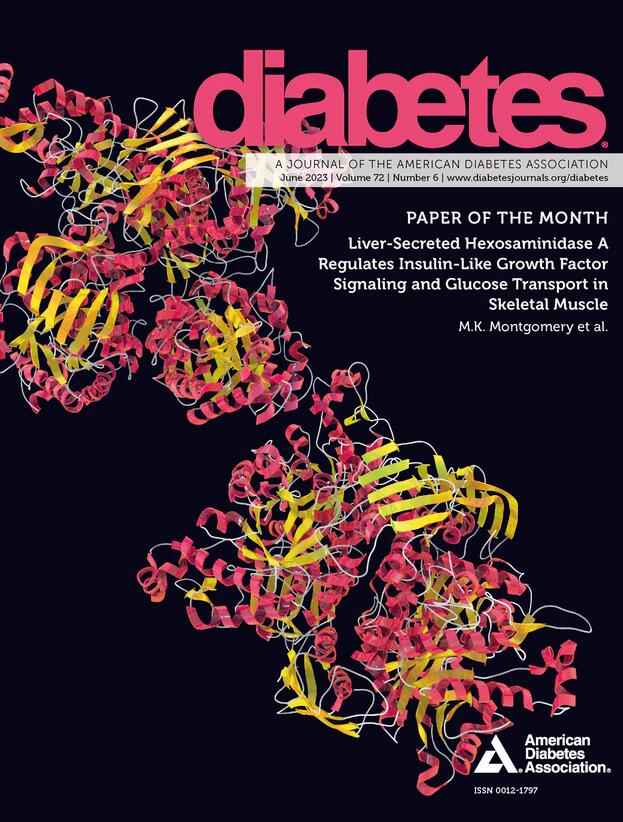322-OR:胎盘GKN1高表达与妊娠β细胞功能降低相关
IF 7.5
1区 医学
Q1 ENDOCRINOLOGY & METABOLISM
引用次数: 0
摘要
简介和目的:我们旨在通过全转录组胎盘基因表达分析,鉴定影响人类妊娠期β细胞功能的候选胎盘蛋白。方法:在Gen3G队列中,我们测量了妊娠24-30周时口服75克葡萄糖负荷后空腹、1小时和2小时的血糖和胰岛素水平。我们计算了妊娠胰岛素生理(PIP)指数,这是衡量妊娠β细胞功能的一种指标。我们对胎盘样本进行了大量RNA测序(N=15,216个RNA转录本),并分析了差异基因表达,以确定在调整母亲年龄、妊娠、体重指数(BMI)、分娩胎龄和后代性别后,与β细胞功能最密切相关的转录本(PIP指数、box-cox转化、标准化)。我们使用错误发现率(FDR)来调整p值。然后,我们用加权线性回归模型量化了鉴定的转录本与其他血糖相关性状之间的名义关联(P<0.05)。结果:在433名队列参与者中,我们发现编码胃激肽1的GKN1是与PIP指数相关的最高差异表达基因。胃激肽1是一种在胃中高度表达的分泌蛋白,被认为在粘膜稳态和脂肪代谢中起作用。较高的胎盘GKN1表达与较低的β细胞功能相关(GKN1表达每SD变化的log2 =-0.44, FDR=8.1×10-6)。妊娠期糖尿病患者胎盘中GKN1的表达高于未受影响的孕妇(log2倍变化=1.13,FDR= 4.2×10-3)。较高的GKN1表达与较高的BMI (β=0.2, P=0.04)、负荷后葡萄糖(β=0.3, P=3.5×10-5)和胰岛素(β=0.2, P=0.007)以及较低的胰岛素敏感性调整后的Stumvoll第一阶段估计值(β=-0.2, P=0.001)相关。结论:妊娠期和妊娠期糖尿病患者胎盘GKN1高表达与β细胞功能降低有关。C.E. power:研究支持;, Dexcom公司将公司。其他关系;Mediflix,威科集团怀特:没有。C. Allard:没有。L.舒克:没有。F.员工;Predicta Biosciences, Illumina, Inc.K.阿德利:没有。A. Edlow:研究支持;默克夏普公司;Dohme公司顾问;默克夏普公司;Dohme Corp, Mirvie, Inc.L. Bouchard:没有。P. Jacques:没有。J.C. Florez:研究支持;诺和诺德公司。S. Karumanchi:顾问;Thermofisher Scientific, Comanche Biopharma。股票/股东;Aggamin Therapeutics,罗氏诊断。其他关系;贝斯以色列女执事医疗中心,雪松西奈医疗中心。希弗特:没有。资助国家卫生研究院(R01HD094150)本文章由计算机程序翻译,如有差异,请以英文原文为准。
322-OR: Higher Placental GKN1 Expression Is Associated with Reduced Pregnancy Beta-Cell Function
Introduction and Objective: We aimed to identify candidate placental proteins that impact beta-cell function in human pregnancy through transcriptome-wide placental gene expression analysis. Methods: In the Gen3G cohort, we measured glucose and insulin levels fasting, 1, and 2 hours after a 75-gram oral glucose load given at 24-30 weeks’ gestation. We calculated the Pregnancy Insulin Physiology (PIP) Index, a measure of pregnancy beta-cell function. We performed bulk RNA sequencing of placental samples (N=15,216 RNA transcripts) and analyzed differential gene expression to identify transcripts most strongly associated with beta-cell function (PIP index, box-cox transformed, standardized) after adjustment for maternal age, gravidity, body mass index (BMI), gestational age at delivery, and offspring sex. We used the false discovery rate (FDR) to adjust P-values. We then quantified nominal associations (P<0.05) between identified transcripts and other glycemia-related traits with weighted linear regression models. Results: In 433 cohort participants, we identified GKN1, encoding gastrokinin 1, as the top differentially expressed gene in relation to the PIP index. Gastrokinin 1, a secreted protein highly expressed in the stomach, has putative roles in mucosal homeostasis and fat metabolism. Higher placental GKN1 expression was associated with lower beta-cell function (log2 change in GKN1 expression per SD change in beta-cell function=-0.44, FDR=8.1×10-6). Placentas from pregnancies with gestational diabetes had higher GKN1 expression compared to unaffected pregnancies (log2 fold change=1.13, FDR= 4.2×10-3). Higher GKN1 expression was associated with higher BMI (β=0.2, P=0.04), post-load glucose (β=0.3, P=3.5×10-5) and insulin (β=0.2, P=0.007), and lower insulin sensitivity-adjusted Stumvoll first phase estimate (β=-0.2, P=0.001). Conclusion: Higher placental GKN1 expression is associated with reduced beta-cell function in pregnancy and gestational diabetes. Disclosure C.E. Powe: Research Support; Dexcom, Inc. Other Relationship; Mediflix, Wolters Kluwer Health. F. White: None. C. Allard: None. L. Shook: None. F. Aguet: Employee; Predicta Biosciences, Illumina, Inc. K. Ardlie: None. A. Edlow: Research Support; Merck Sharp & Dohme Corp. Consultant; Merck Sharp & Dohme Corp, Mirvie, Inc. L. Bouchard: None. P. Jacques: None. J.C. Florez: Research Support; Novo Nordisk. S. Karumanchi: Consultant; Thermofisher Scientific, Comanche Biopharma. Stock/Shareholder; Aggamin Therapeutics, Roche Diagnostics. Other Relationship; Beth Israel Deaconess Medical Center, Cedars-Sinai Medical Center. M. Hivert: None. Funding National Institutes of Health (R01HD094150)
求助全文
通过发布文献求助,成功后即可免费获取论文全文。
去求助
来源期刊

Diabetes
医学-内分泌学与代谢
CiteScore
12.50
自引率
2.60%
发文量
1968
审稿时长
1 months
期刊介绍:
Diabetes is a scientific journal that publishes original research exploring the physiological and pathophysiological aspects of diabetes mellitus. We encourage submissions of manuscripts pertaining to laboratory, animal, or human research, covering a wide range of topics. Our primary focus is on investigative reports investigating various aspects such as the development and progression of diabetes, along with its associated complications. We also welcome studies delving into normal and pathological pancreatic islet function and intermediary metabolism, as well as exploring the mechanisms of drug and hormone action from a pharmacological perspective. Additionally, we encourage submissions that delve into the biochemical and molecular aspects of both normal and abnormal biological processes.
However, it is important to note that we do not publish studies relating to diabetes education or the application of accepted therapeutic and diagnostic approaches to patients with diabetes mellitus. Our aim is to provide a platform for research that contributes to advancing our understanding of the underlying mechanisms and processes of diabetes.
 求助内容:
求助内容: 应助结果提醒方式:
应助结果提醒方式:


